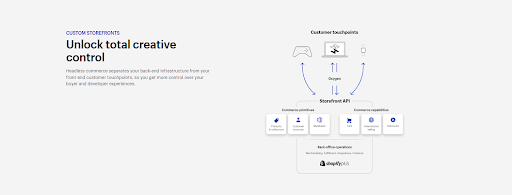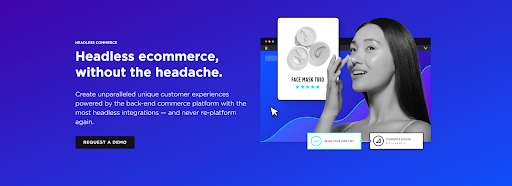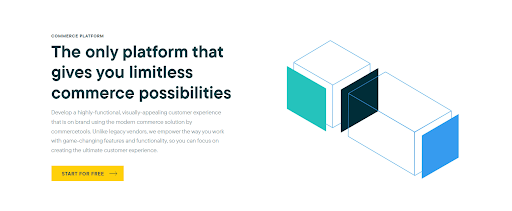/ Articles
Best Headless eCommerce Platforms: From Selection Criteria to Top Picks & Pro Tips
Aakanksha Sharma
Content Marketer
- DATE PUBLISHED (8/9/2023)
- READ TIME (5MIN)
Market trends change constantly. In recent years, eCommerce has evolved to keep up. Before, the focus was mainly on back-end setups. But now, with the rising demand for personalized shopping and seamless experiences across channels, a new eCommerce design has emerged: headless commerce.
More and more businesses are choosing this method. It's not just for one industry, either. From software services to cars, even shoes and clothes brands are jumping on board. They all see the value in providing the best online shopping experiences through headless commerce.
Why is it Important to Choose the Right Headless Commerce Platform?
Let us unpack some key factors that contribute to this critical decision.
Omnichannel as the Essence of eCommerce:
Omnichannel isn't just a buzzword; it's the heartbeat of modern eCommerce. Today's customers expect brands to be present across platforms, from mobile apps and desktop sites to social media. This interconnected shopping journey is what defines today's eCommerce landscape.
Growth Spurred by Omnichannel:
Both startups and established enterprises are recognizing the power of omnichannel. It's not just about expanding reach; it's about creating consistent, high-quality interactions at every touchpoint. This approach has increased customer loyalty, higher conversion rates, and, ultimately, boosted revenues.
The Imperative of Flexibility:
With the rise of omnichannel comes the need for flexibility in eCommerce platforms. Traditional systems, with their rigid structures, can't keep up. This is where headless commerce shines, decoupling the front end from the back end, allowing for agile adaptations to market shifts.
Choosing the Right Platform is Crucial:
It's not just about going headless; it's about selecting a platform that aligns with your business vision and eCommerce goals. Whether aiming for global expansion, targeting niche markets, or focusing on mobile-first strategies, your chosen platform should be a catalyst, not a constraint.
Diversity in Headless eCommerce Platforms:
Not all headless platforms are created equal. Some prioritize ease of use, while others focus on deep customization. Open-source options offer community-driven innovations and proprietary systems with dedicated support. Understanding these nuances is key to making an informed decision.
What Factors to Consider when Choosing the Headless eCommerce Platform?
Below are the 7 factors, along with actionable insights on how to identify and evaluate them when considering a headless commerce platform:
1. Evaluating Business Features:
Analytics: Does the platform provide comprehensive dashboards and reporting tools? Check if you can easily track customer behavior, identify best-selling products, and monitor conversion rates. A demo or trial can help you gauge the depth of their analytics.
Order Management: Investigate the platform's capabilities in handling order processing, tracking, and customer communication. Can it integrate with your existing logistics and fulfillment solutions? Look for features like real-time order updates and easy returns management.
Inventory Management: Ensure the platform can handle real-time inventory tracking across multiple warehouses or locations. Can it alert you about low stock levels or provide insights into inventory turnover? A hands-on test or case studies can be revealing.
2. Assessing Integration Capabilities:
Does the platform have a robust API that seamlessly connects with your essential business tools? Check for pre-built integrations with popular software or tools you currently use. Reading developer documentation or seeking feedback from your tech team can be invaluable here.
3. User Interface & Usability:
Opt for platforms that offer intuitive and user-friendly interfaces. Request a demo or a trial period to get hands-on experience. Can your team, especially non-developers, easily navigate and manage the platform?
4. Customization Potential:
How flexible is the platform in adapting to your specific business needs? Check if it allows for design and functional tweaks without extensive coding. Look for platforms that offer template-based designs for quick setup and deeper customization options for unique requirements.
5. Ensuring Optimal Customer Experience:
Test the platform from a customer's perspective. Is the shopping experience smooth across devices? Does the platform support mobile optimization and SEO tools to enhance discoverability? User testing or feedback from existing clients can provide insights.
6. Support & Security Considerations:
Research the platform's security credentials. Does it comply with industry standards and regulations? Additionally, evaluate the responsiveness and expertise of their support team. Consider checking reviews or reaching out to current users for feedback.
7. Cost Effectiveness:
While evaluating the pricing, consider both immediate costs and long-term value. Does the platform offer scalability without exorbitant price hikes? Are there hidden costs? Comparing feature-to-cost ratios among different platforms can give you a clearer picture.
Quiz - Find the Best Headless Platform for Your Business
1. What's the size of your business?
a) Startup or Small Business
b) Medium-sized Business
c) Large Enterprise
2. How would you rate your team's technical capabilities?
a) Novice - We're just starting.
b) Intermediate - We have some technical know-how.
c) Expert - We have a dedicated tech team.
3. What's your budget for implementing a headless commerce platform?
a) Limited - We're looking for cost-effective solutions.
b) Moderate - We're willing to invest in quality.
c) High - We want the best, regardless of cost.
4. Which feature is most crucial for your business?
a) Comprehensive Analytics and Reporting
b) Seamless Integrations with Other Tools
c) High Customization Potential
5. How important is customer support to you?
a) Essential - We need hands-on support and guidance.
b) Important - We'd like to have support when necessary.
c) Not a Priority - We have our tech team to handle issues.
6. Are you looking for a platform that offers pre-built templates for quick setup?
a) Yes, we prefer ready-made solutions.
b) No, we're looking for unique customization.
7. How do you prioritize security?
a) Top Priority - We want the highest security standards.
b) Important - Standard security measures are fine.
c) Not a Priority - We have our security protocols.
Based on the answers, the quiz can suggest a platform that aligns with the user's needs:
Mostly A's | You might benefit from a beginner-friendly, cost-effective platform tailored for startups or small businesses. |
Mostly B's | A platform that balances features, customization, and cost might suit your medium-sized business. |
Mostly C's | Consider premium platforms that offer extensive features, high customization, and robust security, ideal for large enterprises. |
(Note: The quiz results are hypothetical and would ideally be based on in-depth research of available platforms and their features.)
Best Headless Commerce Platforms
Having understood the significance and considerations of headless commerce, let's now explore the top contenders in the world of headless eCommerce platforms.
1. Shopify Plus

Shopify Plus is tailored for businesses with high transaction volumes. With its React-based framework, Hydrogen, you can swiftly design headless web storefronts. Oxygen, Shopify's global hosting solution, ensures seamless deployment and scalability at no extra cost.
Advantages and Drawbacks of going headless on Shopify Plus
Advantages:
Speed up development using Hydrogen and Oxygen.
Craft dynamic storefronts utilizing the GraphQL Storefront API.
The intuitive admin interface integrates seamlessly with essential business tools like ERP, PIM, CRM, and CMS.
Launch multiple stores under a single brand, catering to diverse languages or currencies.
Enhance your commerce skills with Shopify Plus Academy's on-demand courses.
Streamline processes like customer loyalty programs, segmentation, merchandising, and fraud prevention.
Flexibility in URL customization, allowing continuity from previous stores.
Drawbacks:
Absence of the Shopify theme editor for those utilizing Shopify's backend.
Custom coding is essential for integrating Shopify API with external apps.
Transitioning to Shopify Plus requires developer expertise due to its intricate setup.
Pricing:
Plans begin at $2,000 monthly. Remember to account for initial setup and ongoing maintenance expenses.
2. Big Commerce

BigCommerce stands out as a top-tier platform, allowing businesses to adapt to the ever-evolving e-commerce landscape. With its headless commerce capabilities, BigCommerce ensures that brands can craft unique front-end experiences without compromising their back-end operations.
Advantages and Drawbacks of going headless on BigCommerce.
Strengths:
With BigCommerce, nearly the entire platform is accessible through APIs, making it a breeze to incorporate various e-commerce services.
Beyond its native CMS, BigCommerce supports integration with renowned CMS platforms like WordPress, Prismic, and Contentful.
Its architecture allows for smooth integration with various third-party back-end tools, from CRM systems to order management solutions.
Brands can use modern frameworks like React.js for a more interactive front-end while leveraging BigCommerce's dependable back end.
The decoupled nature ensures quicker website loading, especially when paired with tools like PWAs.
BigCommerce has fine-tuned its platform to ensure smooth operations with WordPress.
Manage stock and inventory across channels from one central hub.
The decoupled design facilitates quicker back-end tests without disruptions.
The shift to headless allows businesses to morph their stores into progressive web apps, enhancing user experience.
Challenges:
Going headless might increase the platforms a business has to oversee.
A customized front-end could add layers to the existing technology stack. Some apps and plugins might require reintegration post-transition.
Certain plugins or features might not be compatible in a decoupled environment.
Moving headless might necessitate revamping the analytics framework to maintain metric tracking.
Pricing:
BigCommerce offers the following pricing for their headless platform:
Standard: $39/month
Plus: $105/month
Pro: From $399/month (additional fees based on online sales)
Enterprise: Custom pricing based on sales volume.
Transaction Fees: 2.59% + $0.49 per card transaction.
All prices are in US Dollars and exclude taxes.
3. Adobe Commerce
Adobe Commerce, driven by Magento, is a game-changer in digital shopping. Celebrated for its adaptability, expansive scale, and comprehensive functionalities, it empowers businesses to design unparalleled frontend interfaces while anchoring a robust backend system. Ideal for established enterprises and growing businesses, Adobe Commerce offers a rich toolkit for e-commerce success. However, its technical intricacies might be a hurdle for budding ventures or those lacking tech expertise.
Advantages and Drawbacks of going headless on Adobe Commerce
Advantages:
Adobe Commerce boasts a vast API spectrum, facilitating smooth integrations and bespoke adjustments.
Its open-source nature allows for customization to fit many business niches, from fashion to tech gadgets.
Effortlessly melds with external systems, encompassing ERP, CRM, and diverse payment gateways.
Equipped to craft universally compatible e-commerce sites, it also champions Progressive Web Apps (PWA) for superior mobile user engagement.
Built-in SEO tools, encompassing metadata management and search-friendly URLs, propel brands to the forefront of search rankings.
Designed to manage vast product assortments, it can effortlessly oversee 500k+ products on a singular server setup.
A thriving ecosystem of developers, enthusiasts, and partners ensures continuous innovation and support.
Limitations:
While the initial access to Magento Open Source doesn't bear a cost, tailored development and upkeep do. The Commerce variant's fee structure commences at $22,000 annually.
The depth of Magento's platform can be daunting for novices or those not well-versed in its technological nuances.
Its multi-layered architecture can extend customization timelines.
Magento's robust nature necessitates potent hosting solutions, sidelining shared hosting in favor of VPS or dedicated setups.
4. CommerceTools

CommerceTools emerges as a cutting-edge player in the e-commerce arena. Beyond its vast suite of features, it champions adaptability and growth potential. Crafted to meet contemporary commerce demands, it provides a holistic shopping experience that can be fine-tuned to supercharge any enterprise.
Advantages and Drawbacks of going headless on Commercetools
Advantages:
CommerceTools is equipped with a diverse range of commerce tools from the start.
Being language-neutral, it amplifies efficiency and offers a broad scope for integration.
Enterprises can shape and expand the platform to resonate with their needs.
Streamlined maintenance combined with the ease of scaling or introducing new features.
CommerceTools is conceived to stay ahead of the curve, ensuring lasting relevance.
Drawbacks -
Given its high customizability, CommerceTools demands a technically adept team for deployment and maintenance. Being a newer platform relative to giants like Shopify or Magento, there might be a limited pool of experienced developers.
CommerceTools comes with a premium price tag. However, it starts with a 60-day free trial period and offers custom pricing afterward. Costs are contingent on business revenue, with additional expenses for development and third-party integrations.
5. Fabric
Fabric emerges as a beacon of innovation in the bustling e-commerce landscape. Fabric offers businesses a streamlined path to upgrade their digital storefronts without the usual hassles. With its blend of modern solutions and a user-first approach, Fabric is a compelling choice for businesses keen on redefining their e-commerce strategies. However, the initial integration phase might demand some patience and guidance.
Advantages and Drawbacks of going headless on Fabric
Advantages:
Fabric is constantly refined, aligning with evolving market demands and addressing user challenges.
Its dashboard is crafted for clarity, enabling users to easily manage and oversee multiple vendors.
Fabric prides itself on providing individualized support guiding businesses, especially during migration.
Fabric's solutions are tailored for the modern age, promoting an API-centric approach that eliminates conventional e-commerce constraints.
Their collaboration with Amazon Web Services underscores Fabric's commitment to delivering top-tier, reliable services, leveraging AWS's renowned cloud prowess.
Drawbacks:
As businesses adapt to Fabric's environment, there's an inherent adjustment period. While users gradually explore all its facets, initial phases might come with challenges.
Pricing:
Starts with $6000 per month.
Bonus Tips for Headless eCommerce Users: Challenges, Maintenance, and Updates
Headless eCommerce offers flexibility and speed, but it's not without its challenges. Here's a quick guide to navigating the potential pitfalls and ensuring smooth operations:
Challenges:
Technical Demands: Headless eCommerce requires a solid technical foundation. Building a custom front end can be complex, especially without a dedicated development team.
Resource Commitment: Separating the front and back end can mean more development work, potentially straining IT resources.
No WYSIWYG: Custom front ends often lack real-time visual editors, making updates less intuitive for marketers.
IT Reliance: A custom front end means more dependency on the IT team, potentially slowing down marketing campaigns.
Maintenance:
Stay Current: Regularly update your platform for the latest features and security enhancements.
Audit Often: Check integrations between the front and back end to ensure optimal performance.
Collaborate: Maintain open communication with your IT team to address challenges promptly.
Updates:
Plan in Advance: Schedule updates ahead of time to minimize disruptions.
Test Before Launch: Always test updates in a controlled setting before going live.
Engage with the Community: Stay updated with industry trends to keep your platform at the forefront.
In essence, while headless eCommerce is promising, it's essential to be aware of its demands. With proactive maintenance and updates, businesses can maximize its benefits.